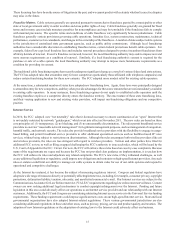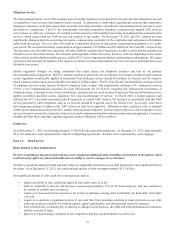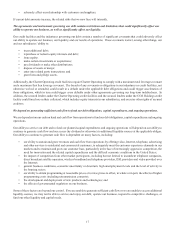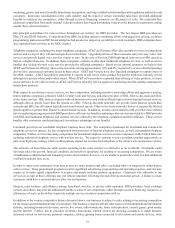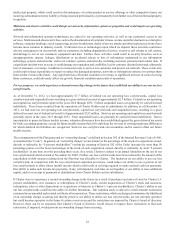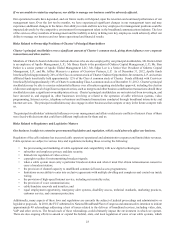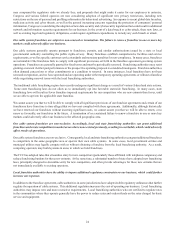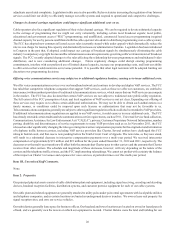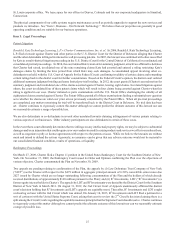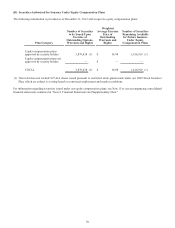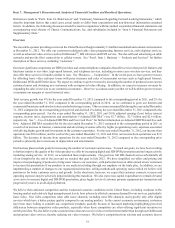Charter 2012 Annual Report Download - page 37
Download and view the complete annual report
Please find page 37 of the 2012 Charter annual report below. You can navigate through the pages in the report by either clicking on the pages listed below, or by using the keyword search tool below to find specific information within the annual report.25
Tax legislation and administrative initiatives or challenges to our tax positions could adversely affect our results of operations
and financial condition.
We operate cable systems in locations throughout the United States and, as a result, we are subject to the tax laws and regulations
of federal, state and local governments. From time to time, various legislative and/or administrative initiatives may be proposed
that could adversely affect our tax positions. There can be no assurance that our effective tax rate or tax payments will not be
adversely affected by these initiatives. As a result of state and local budget shortfalls due primarily to the recession as well as other
considerations, certain states and localities have imposed or are considering imposing new or additional taxes or fees on our
services or changing the methodologies or base on which certain fees and taxes are computed. Such potential changes include
additional taxes or fees on our services which could impact our customers, combined reporting and other changes to general
business taxes, central/unit-level assessment of property taxes and other matters that could increase our income, franchise, sales,
use and/or property tax liabilities. In addition, federal, state and local tax laws and regulations are extremely complex and subject
to varying interpretations. There can be no assurance that our tax positions will not be challenged by relevant tax authorities or
that we would be successful in any such challenge.
Further regulation of the cable industry could cause us to delay or cancel service or programming enhancements, or impair
our ability to raise rates to cover our increasing costs, resulting in increased losses.
Currently, rate regulation of cable systems is strictly limited to the basic service tier and associated equipment and installation
activities. However, the FCC and Congress continue to be concerned that cable rate increases are exceeding inflation. It is possible
that either the FCC or Congress will further restrict the ability of cable system operators to implement rate increases for our video
services or even for our high-speed Internet and telephone services. Should this occur, it would impede our ability to raise our
rates. If we are unable to raise our rates in response to increasing costs, our losses would increase.
There has been legislative and regulatory interest in requiring cable operators to offer historically combined programming services
on an á la carte basis. It is possible that new marketing restrictions could be adopted in the future further affecting our preferred
provisioning of services and related equipment. Such restrictions could adversely affect our operations.
Actions by pole owners might subject us to significantly increased pole attachment costs.
Pole attachments are cable wires that are attached to utility poles. Cable system attachments to investor-owned public utility poles
historically have been regulated at the federal or state level, generally resulting in favorable pole attachment rates for attachments
used to provide cable service. In contrast, utility poles owned by municipalities or cooperatives are not subject to federal regulation
and are generally exempt from state regulation. In 2011, the FCC amended its pole attachment rules to promote broadband
deployment. The order (the "Order") maintains the basic rate formula applicable to "cable" attachments in the 30 states directly
subject to FCC regulation, but reduces the rate formula previously applicable to "telecommunications" attachments to make it
roughly equivalent to the cable attachment rate. The Order maintains the status quo treatment of cable-provided VoIP service as
an unclassified service eligible for the favorable cable pole attachment rates, but the issue has not been fully resolved by the FCC,
and a change in classification could subject our pole attachment rates to the higher rates governing telecommunications attachments.
The Order also allows for new penalties in certain cases involving unauthorized attachments that could result in additional costs
for cable operators. The Order overall strengthens the cable industry's ability to access investor-owned utility poles on reasonable
rates, terms and conditions. Electric utilities filed Petitions for Reconsideration at the FCC and Petitions for Review in the D.C.
Circuit Court of Appeals seeking to modify or overturn the FCC’s Order. Charter and other cable operators have intervened in
the court proceeding in support of the FCC. The outcome of these proceedings could impact the pole attachment rates we pay
utility companies.
Increasing regulation of our Internet service product could adversely affect our ability to provide new products and services.
In December 2010, the FCC adopted new “net neutrality” rules it deemed necessary to ensure continuation of an “open” Internet
that is not unduly restricted by network “gatekeepers.” The new rules, which went into effect in November 2011, are based on
three core principles of: (1) transparency, (2) no blocking, and (3) no unreasonable discrimination. The rules permit broadband
service providers to exercise “reasonable network management” for legitimate management purposes, such as management of
congestion, harmful traffic, and network security. The rules also provide broadband service providers with the flexibility to engage
in usage-based billing and offer additional specialized services, such as facilities-based IP voice services, without being subject
to restrictions on discrimination. Although the rules encompass both wireline providers (like us) and wireless providers, the rules
are less stringent with regard to wireless providers. Verizon and other parties have filed for additional FCC review, as well as
filing an appeal challenging the FCC’s authority to issue such rules, which will be heard by the U.S. Court of Appeals for the D.C.
Circuit. For now, the FCC will enforce these rules based on case-by-case complaints. Because many of the requirements are vague
and because the FCC has not provided clear guidance on implementation, it is unclear how the FCC will enforce its rules and


